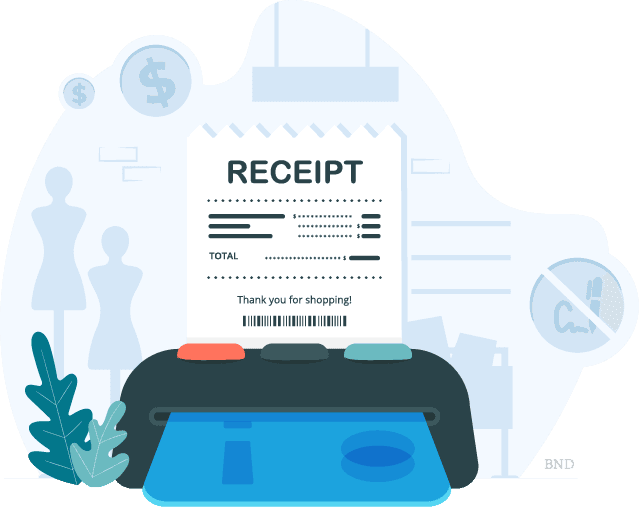Business News Daily provides resources, advice and product reviews to drive business growth. Our mission is to equip business owners with the knowledge and confidence to make informed decisions. As part of that, we recommend products and services for their success.
We collaborate with business-to-business vendors, connecting them with potential buyers. In some cases, we earn commissions when sales are made through our referrals. These financial relationships support our content but do not dictate our recommendations. Our editorial team independently evaluates products based on thousands of hours of research. We are committed to providing trustworthy advice for businesses. Learn more about our full process and see who our partners are here.
Should Small Businesses Require Receipt Signatures?
: In a digital era, do you still need to require receipt signatures?

Table of Contents
Many merchants breathed a sigh of relief when Visa, Mastercard, Discover and American Express announced they were no longer collecting signatures on credit card or debit card transactions due to the advent of EMV technology. But is there still a reason why you should consider collecting signatures? In this guide, we’ll go into detail about what a credit card receipt is, what information is included on a receipt, why customer signatures were required in the first place, the security standards that replace the signature and practical tips that cardholders can implement to keep their cards out of the wrong hands.
What is a credit card receipt?
A credit card receipt is a printout or email detailing the components of a transaction. Vendors, retailers and merchants may provide customers with a credit card receipt, which is proof of transaction for payment of goods and services. The vendor’s point-of-sale (POS) system generates a receipt and prints it for the payer.
What information is on a credit card receipt?

Since consumer privacy is part of the Fair and Accurate Credit Transactions Act, certain information must be present on a credit card receipt:
- Your primary account number (PAN): Your PAN is a condensed version of your full card number. Your PAN is typically the last four digits of your full card number.
- Transaction information: This includes the date, time and total transaction amount. Some vendors will itemize each item purchased and its price.
- Vendor information: The vendor’s name, address and merchant ID tells the payment processing system where to send the payment.
- Authorization code: This is the approval code for the transaction, authorized by the card company. It states the buyer has enough funds available for the purchase.
Why were customer signatures required?
For decades, credit card companies relied on receipt signatures to prevent fraud. They required merchants to collect and store customer signatures so that if a transaction was disputed, the merchant could produce a signed receipt proving the customer was physically in the store and personally approved the purchase. Without this proof, merchants were on the hook for losses due to charge-backs. They were also liable if the signature on the receipt didn’t match the signature on file or on the card. With the advancement of EMV-compliant card readers, chip readers have replaced customer signatures.
Chip readers replacing customer signatures
In 2015, credit card companies began issuing chip cards to consumers. This shifted liability for counterfeit fraud occurring at the point of sale to merchants who hadn’t yet upgraded to EMV-compliant card readers. This laid the groundwork to shift away from signatures since chip cards and digital wallets have advanced anti-fraud technologies, such as tokenization and biometrics, to authenticate transactions. This technology renders credit card signature requirements obsolete.
How no-signature transactions work
Prior to EMV technology, signing a receipt was the standard for authenticating a credit card purchase. Visa, Discover, Mastercard and American Express eliminated customer signatures on all credit card purchases. Signature requirements did not prevent fraud and the process wasn’t as secure. Credit card companies found a more secure way to protect the cardholder from fraud or inauthentic transactions while speeding up the in-store checkout process. Here are three things you should know about the process of no-signature transactions:
- The cardholder retains possession of the card. Previously, some merchants would be in charge of the swipe. This allowed for card skimming ― or card duplication ― if it wound up in the hands of the wrong merchant.
- When you insert your chip card into a top POS system, you’ll see a “do not remove card” message. During this time, the chip, which is the microcomputer on the card, sends a message to the credit card company and the credit card company replies. Once it’s authenticated, the cardholder is prompted to remove the card.
- Every chip-card transaction generates an unrepeatable code. If a hacker accesses your transaction number, that number would not work for future purchases and would alert EMV technology to the scam.
In 2018, the big four credit card companies allowed EMV-compliant merchants to expedite signature-free checkout. Big-box retailers, such as Walmart and Target, applauded the decision. A speedier checkout process, eliminating the need to save receipts and using resources to store receipts, factored into the adoption of EMV.
Should your business stop asking customers to sign credit card receipts?
Even though large retailers quickly dropped their credit card signature requirements following the card brands’ announcements, some merchants continue to collect customer signatures on debit and credit card transactions. [Learn more about accepting credit card payments by reading our guide.]
Before you decide which option makes the most sense for your business, here are a few factors to consider.
1. Is your business EMV-compliant?
If you haven’t yet updated your credit card readers to EMV-compliant models, you aren’t eligible to skip signature verification for Visa and Discover transactions.
Visa reports that, as of March 2019, 75% of United States storefronts have embraced EMV technology. That leaves 25% that have yet to upgrade their systems. If you’re still holding out on EMV technology, speak with your credit card processor about updating your card reader. In addition to enabling you to stop collecting receipt signatures, it significantly lowers your risk of counterfeit credit card fraud at the point of sale.
Despite the lack of a signature requirement for the past year, EMV technology has been effective against fraud. Visa reports that, as of September 2018, EMV-compliant merchants have seen counterfeit fraud drop 76% since September 2015. EMV has increased in popularity for merchants and consumers. Currently, EMV accounts for 86.1% of in-store transactions. [Interested in the best credit card processing for your business? Check out our reviews and top picks.]
2. Does your POS system allow you to eliminate signature authorization for credit card transactions?
If you already have an EMV-compliant credit card terminal or card reader, the next step is to check with your POS system provider to find out if the software has been updated to remove this step from the checkout process.
Many POS providers have updated their systems to let merchants choose whether they want to continue requiring customers to sign for purchases. Some, such as Square, offer multiple receipt signature options. You can choose to always require receipt signatures, never require receipt signatures or only require receipt signatures for transactions over $25.
3. Does your business use signatures for proof of approval?
If your business uses receipt signatures for other purposes, such as approving a work order, accepting completed work or agreeing to a sales policy (such as “all sales are final”), you may need to keep collecting receipt signatures.
Writing for 360 Payments, Lisa Coyle says, “Even if you decide that you are ready to do away with them on your EMV credit card receipts, you may find value in adding a signature requirement to your contract or work order. Signatures are good for much more than authorizing a credit card transaction.”
Restaurants are also likely to continue requiring receipt signatures to encourage tipping. If, for instance, your business is a sit-down restaurant that doesn’t have a pay-at-the-table option allowing patrons to add a tip before paying the bill with a card, it probably doesn’t make sense to forgo receipt signatures. It’s less awkward to ask customers to sign paper receipts with tip prompts than to ask them the amount they want to tip before you charge their credit cards.
4. Are you nervous about charge-backs or credit card fraud?
All merchants may be nervous about charge-backs or credit card fraud. Merchants who have adopted EMV-compliant technologies should be far less concerned. At the inception of EMV-compliant technology in 2015, critics worried the chip-and-sign process was less secure than the chip-and-PIN. Unlike magnetic-stripe cards, which originated in the 1960s and are borderline obsolete today, chip cards are nearly impossible to duplicate. This reduces credit card fraud and increases authenticity. Likewise, because of EMV’s heightened anti-fraud technology and increased security, merchants have less liability for a charge-back.
How to keep credit card information safe

Although the big four credit card companies no longer require a cardholder to sign the back of a card, since EMV-compliant systems generally are regarded as secure, you and your customers may wish to take extra precautions to ensure account safety. Here are some everyday tips for cardholders:
- Don’t let others use your credit card: If you want someone to make a purchase on your behalf, add them as an authorized user to your credit card account. This also ensures no holdups at the business, where personnel can easily verify the identity of the person using the card if necessary.
- Don’t leave your card unattended. A lost or stolen card can be used anywhere, creating a headache for merchants and customers alike.
- Monitor your online accounts. Alert the merchant and your credit card company or bank to any fraudulent charges.
Should you keep your credit card receipts?
Keeping credit card receipts can be advantageous for customers and businesses.
Why customers should keep receipts
There are several reasons a customer may keep receipts:
- To reconcile their credit card statement
- In the event that a customer wants to return or exchange an item
- For tax purposes
- If the product has a warranty or is eligible for a mail-in rebate
Keep in mind that businesses act not only as a supplier but also as a consumer when they purchase products.
Why businesses should keep receipts
The reasons a consumer may keep receipts also apply to a business owner when it acts as a consumer. Here are additional reasons a business may keep receipts:
- For tax purposes, both for income and expenses (the IRS advises business owners to keep records for three years)
- To help prepare financial statements, whether monthly, quarterly or annually
- To help reconcile, budget and manage inventory
- To monitor your income and expenses so you can make sound business decisions
Signatures and receipts are an important part of record-keeping
Whether you capture them digitally or prefer to have physical copies, verifying customer transactions with signatures and receipts can help improve your records and demonstrate to payment processors the validity of your transactions. You never know when having these records may pay off and employing a POS system or accounting software that can easily capture this information and archive it for future use can make things easier. By leveraging modern technology you can strike the balance between streamlining payments and protecting your business.
Stella Morrison and Tejas Vemparala contributed to this article.




